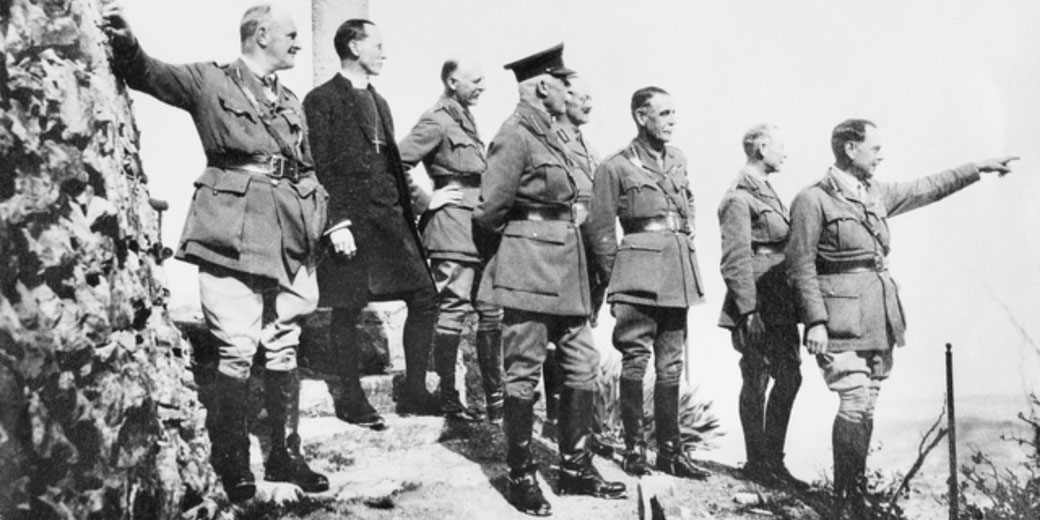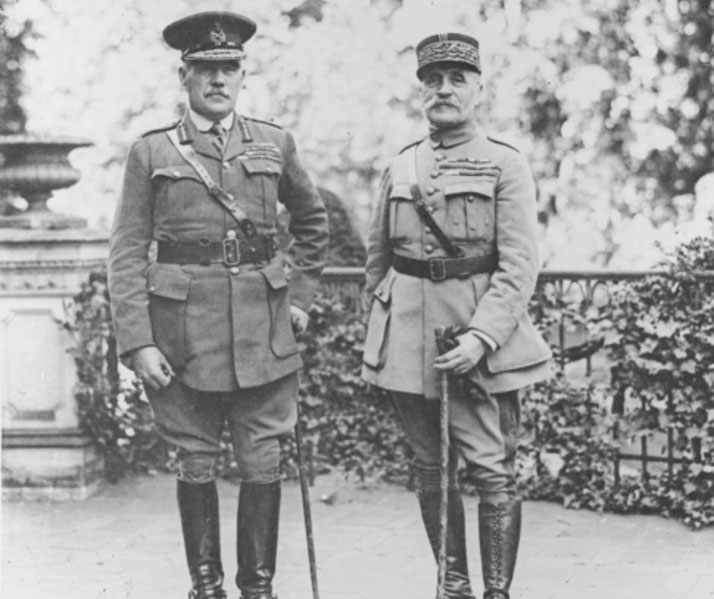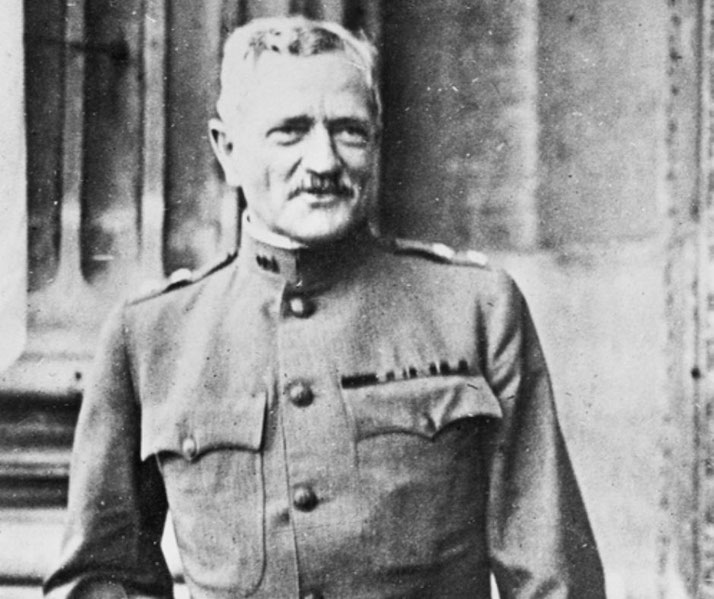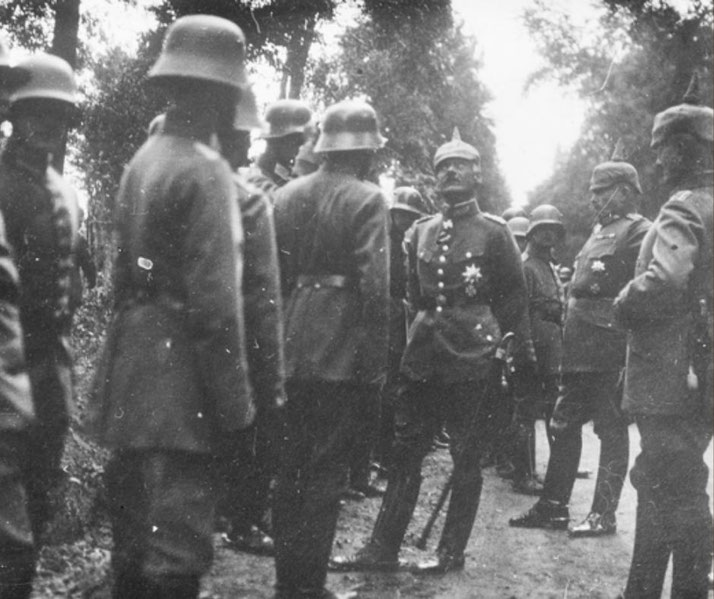The top 10 generals who shaped WWI

As the guns of World War I roared across Europe, it was the military generals who created the complex strategies and tactics for the battlefields.
These men were faced with the challenge of leading their countless men through the uncharted territory of modern warfare.
They were often under immense pressure, fully aware that the fate of nations, and millions of lives, rested on their shoulders.
But who were these figures who commanded millions, decided the fates of battles?
And how did their decisions influence the outcome of the war?
1. Ferdinand Foch
Born on October 2, 1851, in Tarbes, France, Foch's military career was distinguished long before the outbreak of the Great War.
However, it was during this global conflict that his strategic acumen truly came to the forefront.
In the early years of the war, Foch played a crucial role in the First Battle of the Marne, which took place from September 6 to 12, 1914.
His decisive actions and the counter-attack strategy he employed were instrumental in preventing the German forces from advancing into Paris.
However, Foch's reputation as a master strategist was further solidified during the Battle of the Somme in 1916.
Here, he served under General Joseph Joffre.
While this battle has become famous for its heavy casualties, Foch's leadership was noted for its resilience and tactical ingenuity.
His ability to adapt to the evolving nature of trench warfare demonstrated a deep understanding of the changing dynamics of modern combat.
Perhaps the most defining moment of Foch's military career came in 1918. On March 26 of that year, when the war was at a critical juncture, Foch was given the responsibility to coordinate the actions of the Allied forces on the Western Front.
This appointment had come at a time when the German Army had launched a major offensive, which threatened to finally overwhelm the Allied forces.
Under his new leadership, the Allied forces then launched a series of counteroffensives, which started in the summer of 1918.
These offensives were pivotal in pushing back the German forces.
Foch's strategy of coordinated, successive attacks across the Western Front culminated on November 11, 1918, when the Armistice was signed in Compiègne, France.
The war was over and the Allies emerged victorious, thanks in part to Foch's leadership.
After the war, Foch was hailed as a hero in France and received numerous honors and accolades for his service.

2. Erich Ludendorff
Erich Ludendorff was one of the most vital figures in the German military during World War I.
His military career reached a turning point as a result of his involvement in the Battle of Liège in August 1914, during of the German invasion of Belgium.
Ludendorff's leadership was instrumental in the capture of Liège, for which he was hailed as a hero in Germany.
Ludendorff's strategic prowess was further demonstrated in the Battle of Tannenberg in late August 1914.
Alongside Paul von Hindenburg, Ludendorff engineered a surprising and decisive victory against the Russian Second Army.
This victory significantly weakening the Russian forces and established Ludendorff as a prominent military tactician in the German war effort.
Then, in 1916, Ludendorff was appointed as the Quartermaster General, effectively making him the top military commander alongside Hindenburg.
In this role, he had a significant influence on German military strategy and policy.
One of Ludendorff's major initiatives was the unrestricted submarine warfare campaign of1917.
This aimed to cut off Britain from its overseas resources. Unfortunately, it also played a role in bringing the United States into the war, a development that would have far-reaching consequences.
Perhaps the most ambitious and defining moment of Ludendorff's military career was the Spring Offensive of 1918.
It was officially known as the Kaiserschlacht (Kaiser's Battle) and began on March 21, 1918.
This offensive initially achieved significant gains against the Allied forces by pushing them back on several key fronts.
However, the lack of clear strategic objectives and the eventual counterattacks by Allied forces, including the notable Hundred Days Offensive, led to the overall failure of the Spring Offensive.
This led to the eventual retreat and defeat of German forces.
The weight of these events took a toll on Ludendorff, who, by October 1918, was advocating for an immediate armistice.
By this point, he recognized Germany's untenable position and Ludendorff resigned from his position in October 1918.
This was just weeks before the Armistice.
3. John J. Pershing
Pershing's journey in World War I began in earnest when he was appointed to lead the American Expeditionary Force in May 1917, following the United States' entry into the war.
This appointment came at a critical time, as the Allied powers were struggling against the might of the Central Powers.
As a result, Pershing's arrival in Europe with American troops was a much-needed boost to the Allied morale.
However, he insisted that American forces would operate as an independent unit rather than being amalgamated into British and French forces.
One of Pershing's most significant contributions was his emphasis on rigorous training: he was determined that American forces would enter the battlefield well-prepared.
This approach was evident in the AEF's first major engagement, the Battle of Cantigny, on May 28, 1918.
However, the defining moment of Pershing's military leadership came during the Meuse-Argonne Offensive, which began on September 26, 1918.
It would last until the end of the war in November and was part of a series of Allied attacks known as the Hundred Days Offensive.
As part of this strategy, the Meuse-Argonne Offensive was the largest operation of the American Expeditionary Forces during World War I, involving over 1.2 million American soldiers.
Under Pershing's command, the AEF played a crucial role in breaking through the heavily fortified German lines.

4. Douglas Haig
Douglas Haig remians one of the most controversial figures of World War I. He served as the commander of the British Expeditionary Force (BEF) on the Western Front from late 1915 until the end of the war.
Born on June 19, 1861, in Edinburgh, Scotland, Haig enjoyed a rapid advancement through the ranks in his military career.
Haig's tenure as a commander in World War I was characterized by some of the most brutal and pivotal battles of the war.
One of his earliest tests came with the Battle of the Somme, which began on July 1, 1916.
This battle, while intending to relieve pressure on the French forces at Verdun, turned into one of the bloodiest battles in human history.
Despite the shockingly high casualties, Haig's commitment to the offensive was unwavering.
Unfortunately, this was a stance that has been the subject of much debate among historians, even today.
The Somme did, however, yield some strategic benefits, including the depletion of German resources and manpower.
Then, in 1917, Haig directed another major campaign: the Third Battle of Ypres, commonly known as the Battle of Passchendaele.
Beginning on July 31, 1917, this battle was aimed at breaking through the German defenses and capturing the submarine bases on the Belgian coast.
However, the battle quickly became synonymous with the most horrific of conditions of trench warfare.
This was primarily due to the heaviest rainfalls in 30 years, which turned the battlefield into a muddy quagmire.
The offensive, which lasted until November, did achieve modest territorial gains but at a great cost in terms of casualties.
This only led to further debate over Haig's leadership and strategy.
Despite these controversies, Haig's role in the final year of the war was crucial. In 1918, he faced the German Spring Offensive, a series of German attacks that threatened to split the Allied forces.
But, Haig's famous "Backs to the wall" order of April 11, 1918, is often cited as a key moment in rallying the BEF to withstand the German assault.
Following this, Haig played a significant role in the Allied counteroffensives that began in the summer of 1918.
His leadership in the Hundred Days Offensive, starting in August 1918, was instrumental in pushing back the German forces, leading to the eventual Allied victory.
After the war, Haig was made an earl and received numerous honors, but his legacy remains complex.
He has been both praised for his role in leading the British Army to victory and criticized for the perceived futility of some offensives under his command.
He passed away on January 29, 1928, but the discussions around his military decisions and their impact on the course of World War I continue to this day.
5. Paul von Hindenburg
Born on October 2, 1847, in Posen, Prussia (now Poznań, Poland), Hindenburg's military career spanned several decades, culminating in his leadership roles during the Great War.
Hindenburg's emergence as a key military leader in World War I was somewhat unexpected.
This is because he was called out of retirement at the age of 66 to take command of the German Eighth Army on the Eastern Front.
However, his appointment coincided with the early stages of the war in 1914, a critical period for the German military.
Hindenburg, along with his chief of staff, Erich Ludendorff, achieved a remarkable victory at the Battle of Tannenberg, which took place from August 26 to 30, 1914.
Following the success at Tannenberg, Hindenburg and Ludendorff led German forces to another victory at the Battle of the Masurian Lakes in September 1914.
Due to these successes, in 1916, Hindenburg was appointed as Chief of the General Staff.
This effectively made him the top military commander in Germany, alongside Ludendorff.
In this position, Hindenburg played a crucial role in shaping Germany's military strategy on both the Eastern and Western Fronts.
One of the key aspects of Hindenburg's leadership was the development and implementation of the Hindenburg Line.
This a formidable system of defenses on the Western Front, which played a significant role in the battles of 1917 and 1918.
As the war progressed though, Hindenburg faced the challenge of managing dwindling resources and mounting casualties.
The German Spring Offensive of 1918, which he fully endorsed, initially achieved significant gains but ultimately failed to deliver the decisive victory Germany so desperately needed.
After the war, Hindenburg's legacy continued to evolve. He entered politics and was elected as the President of Germany in 1925, a position he held until his death in 1934.

6. Luigi Cadorna
Luigi Cadorna was a prominent Italian military leader during World War I and is a figure often remembered for his controversial tactics and the heavy casualties under his command.
Cadorna was appointed as the Chief of Staff of the Italian Army in 1914, just before Italy's entry into the war in 1915.
His tenure as a military leader was marked by a series of battles along the Isonzo River, known as the Battles of the Isonzo.
The Isonzo battles, a series of twelve battles between Italy and Austria-Hungary from June 1915 and lasted until late 1917, followed Cadorna's strategy of frontal assaults against well-entrenched Austro-Hungarian positions in the mountainous terrain along the Isonzo River.
In the face of increasingly challenging conditions and the formidable defenses of the enemy, Cadorna persisted with this approach.
The repeated offensives, while showing initial promise, ultimately resulted in staggering casualties without significant strategic gains.
One of the most notable episodes in Cadorna's military career was the Eleventh Battle of the Isonzo, conducted from August to September 1917.
It represented one of the largest Italian offensives during the war, involving nearly 600,000 troops, but did not yield a decisive breakthrough.
The turning point for Cadorna came with the disastrous Battle of Caporetto in October 1917, where the Italian Army suffered a severe defeat at the hands of the Austro-Hungarian and German forces.
It led to a significant retreat of Italian forces and exposed serious flaws in Cadorna's leadership and strategy.
As a result, Cadorna faced criticism for his harsh disciplinary measures and the lack of adequate preparation in response to the enemy's tactics.
Following the defeat at Caporetto, Cadorna was relieved of his command, which ended his direct involvement in World War I.
7. Alexei Brusilov
Alexei Brusilov joined the Imperial Russian Army and steadily rose through the ranks thanks to his tactical skill.
His most significant contribution to World War I was the Brusilov Offensive in 1916.
Launched on June 4, 1916, this offensive was tried to cripple the Austro-Hungarian forces on the Eastern Front.
What set the Brusilov Offensive apart was its use of shock tactics and precise artillery barrages: both of which were relatively new concepts at the time.
Brusilov prepared meticulously for the offensive and employed a strategy of surprise by targeting weak points in the enemy's lines.
The initial phase of the Brusilov Offensive was remarkably successful. The Russian forces broke through the Austro-Hungarian defenses and captured large sections of enemy territory.
In addition, the offensive also forced Germany to divert troops from the Western Front to assist its Austro-Hungarian ally, thereby relieving some pressure on the Allied forces in the west.
However, the Brusilov Offensive eventually lost momentum. The initial successes were not adequately exploited due to logistical challenges and a lack of reserves.
Despite this, the Brusilov Offensive is credited with severely weakening the Austro-Hungarian Army, contributing to its eventual collapse.
After the Russian Revolution in 1917, Brusilov's role in the military changed significantly.
He briefly aligned with the Bolsheviks, serving in administrative positions, but his association with the new regime was complex and short-lived.
8. Mustafa Kemal Atatürk
Mustafa Kemal Atatürk, who would later become the founder and first President of the Republic of Turkey, was an important military leader in the Ottoman Empire during World War I.
Born on May 19, 1881, in Salonica (now Thessaloniki, Greece), Atatürk's military acumen became evident during the Gallipoli Campaign.
The campaign, which began in April 1915, was a major Allied operation aimed at securing a sea route to Russia and capturing the Ottoman capital, Constantinople (now Istanbul).
Atatürk, then a lieutenant colonel, played a critical role in the defense of the Gallipoli Peninsula, particularly during the Battle of Chunuk Bair in August 1915.
Atatürk's command of the Turkish 19th Division was instrumental in repelling the Allied forces, made up of the Australian and New Zealand Army Corps (ANZACs).
Atatürk's defense strategies at Gallipoli relied up an effective use of terrain, quick decision-making, and an ability to inspire his troops.
His famous order, "I am not ordering you to attack, I am ordering you to die," exemplified this.
As a result, the successful defense of Gallipoli under Atatürk's leadership was a significant morale booster for the Ottoman forces.
It is often credited with laying the groundwork for his future political and national leadership.
Following the Gallipoli Campaign, Atatürk continued to serve in various capacities in the Ottoman Army.
However, it was his role in the War of Independence that followed World War I that solidified his status as a national hero.
Atatürk's military successes against the occupying Allied forces after the war were instrumental in the establishment of the modern Turkish Republic.
9. Joseph Joffre
Joffre was appointed Chief of the French General Staff in 1911. His most notable achievement came during the First Battle of the Marne, which took place from September 6 to 12, 1914.
As German forces advanced through Belgium and into France, their swift progress threatened to encircle Paris and potentially force a quick French surrender.
Joffre orchestrated a rapid counter-offensive that involved a risky, but ultimately successful, maneuver to attack the exposed flank of the advancing German army.
This action halted the German advance and forced them to retreat, preventing the quick victory they had anticipated.
However, the success of the Marne not only saved Paris but also set the stage for the prolonged trench warfare that would characterize much of the Western Front for the remainder of the war.
Joffre's calm demeanor and steadfastness during this critical period earned him the nickname "Papa Joffre" among French troops, reflecting the respect and affection he commanded.
However, Joffre's tenure as the Chief of the French General Staff continued to see high casualties in subsequent battles, such as the Battle of Verdun in 1916.
As a result, the perceived lack of decisive breakthroughs led to criticism of his leadership.
In December 1916, amidst growing discontent and political pressure, Joffre was replaced by General Robert Nivelle.
Lter, Joffre was elevated to the ceremonial position of Marshal of France, but his active role in the war's strategic decision-making effectively ended.
10. Arthur Currie
Arthur Currie, a key Canadian military leader during World War I, is remembered for his effective and innovative approach to warfare, which significantly contributed to the success of the Canadian Corps on the Western Front.
Born on December 5, 1875, in Napperton, Ontario, Currie rose from a militia background to become the first Canadian-appointed commander of the Canadian Corps in June 1917, a position he held until the end of the war.
Currie's leadership was first notably demonstrated at the Battle of Vimy Ridge, which took place from April 9 to 12, 1917.
Although the planning and initial stages of the battle were under the command of his predecessor, Currie played a significant role in its execution.
The battle is often cited as a defining moment for Canada in World War I, as the Canadian Corps successfully captured a key German position that had resisted previous Allied attempts.
Currie's emphasis on thorough preparation, detailed planning, and innovative tactics, such as the creeping barrage, were crucial to this success.
After Vimy Ridge, Currie's reputation as a capable commander was further solidified.
He led the Canadian Corps through several key battles, including the Battle of Hill 70 in August 1917 and the Battle of Passchendaele in the fall of 1917.
At Hill 70, Currie's strategy of capturing and holding a key German-held high ground resulted in a significant tactical victory, demonstrating his ability to execute complex operations effectively.
Currie's approach to warfare was characterized by careful planning and a strong emphasis on minimizing casualties, a stance that sometimes put him at odds with the high command.
He was known for his insistence on adequate artillery support and thorough training for his troops, which contributed to the Canadian Corps' reputation as an effective fighting force.
One of Currie's most significant contributions came during the Hundred Days Offensive in 1918, the final push by the Allies that led to the end of the war.
Under his command, the Canadian Corps played a pivotal role in several battles during this offensive, including the Battle of Amiens in August 1918, where their rapid advance and tactical efficiency were crucial to the Allied success.
What do you need help with?
Download ready-to-use digital learning resources
Copyright © History Skills 2014-2025.
Contact via email
With the exception of links to external sites, some historical sources and extracts from specific publications, all content on this website is copyrighted by History Skills. This content may not be copied, republished or redistributed without written permission from the website creator. Please use the Contact page to obtain relevant permission.





